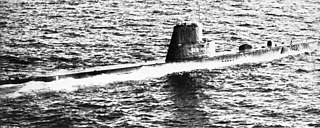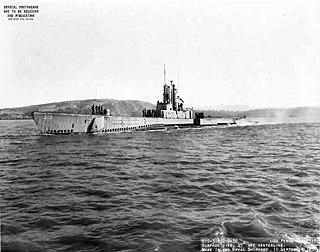 W
WThe Balao class was a successful design of United States Navy submarine used during World War II, and with 120 boats completed, the largest class of submarines in the United States Navy. An improvement on the earlier Gato class, the boats had slight internal differences. The most significant improvement was the use of thicker, higher yield strength steel in the pressure hull skins and frames, which increased their test depth to 400 feet (120 m). Tang actually achieved a depth of 612 ft (187 m) during a test dive, and exceeded that test depth when taking on water in the forward torpedo room while evading a destroyer.
 W
WThe Gato class of submarines was built for the United States Navy and launched in 1941–1943; they were the first mass-production U.S. submarine class of World War II. Together with their near-sisters the Balao and Tench classes, their design formed the majority of the United States Navy's World War II submarine fleet. Named after the lead ship of the class, USS Gato, the Gatos and their successors formed the core of the submarine service that was largely responsible for the destruction of the Japanese merchant marine and a large portion of the Imperial Japanese Navy in World War II. Gato's name comes from a species of small catshark. Like most other U.S. Navy submarines of the period, boats of the Gato class were given the names of marine creatures. In some references, the Gatos are combined with their successors, especially the Balao class.
 W
WTench-class submarines were a type of submarine built for the United States Navy (USN) between 1944 and 1951. They were an improvement over the Gato and Balao classes, only about 35 to 40 tons larger, but more strongly built and with a slightly improved internal layout. One of the ballast tanks was converted to carry fuel, increasing range from 11,000 nautical miles to 16,000 nautical miles. This improvement was also made on some boats of the previous two classes. Further improvements were made beginning with SS-435, which are sometimes referred to as the Corsair class. Initial plans called for 80 to be built, but 51 were cancelled in 1944 and 1945 when it became apparent that they would not be needed to defeat Japan. The remaining 29 were commissioned between October 1944 (Tench) and February 1951 (Grenadier). The last submarine of the Tench class, as well as the last submarine which served during World War II, remaining in service with the U.S. Navy was USS Tigrone (AGSS-419) which was decommissioned on 27 June 1975.
 W
WUSS Besugo (SS/AGSS-321), a Balao-class submarine, was a ship of the United States Navy named for the besugo.
 W
WUSS Blenny (SS/AGSS-324), a Balao-class submarine, was a ship of the United States Navy named for the blenny, a fish found along the rocky shores of the Atlantic Ocean.
 W
WUSS Bugara (SS-331), a Balao-class submarine, was a ship of the United States Navy named for the bugara, a multicolored fish found along the coast of California.
 W
WUSS Carp (SS/AGSS/IXSS-338), a Balao-class submarine, was the second ship of the United States Navy to be named for the carp.
 W
WUSS Charr (SS/AGSS-328), a Balao-class submarine, was a ship of the United States Navy named for the charr.
 W
WUSS Greenfish (SS-351) was a Balao-class submarine of the United States Navy. It was named for the greenfish.
 W
WThe second USS Menhaden (SS-377) was United States Navy Balao-class submarine. Launched in 1944, she operated out of Pearl Harbor until 1946, then continued in use out of various ports in the Pacific until the 1970s. She was then decommissioned and re-fitted as a remotely controlled, unmanned acoustic test vehicle known as the "Yellow Submarine", until she was scrapped in 1988.
 W
WUSS Perch (SS/SSP/ASSP/APSS/LPSS/IXSS-313), a Balao-class submarine, was the second submarine of the United States Navy to be named for the perch, a rather small European fresh-water spiny-finned fish.
 W
WUSS Pickerel (SS-524), a Tench-class submarine, was the second ship of the United States Navy to be named for a young or small pike. The contract to build her was awarded to the Boston Naval Shipyard and her keel was laid down on 8 February 1944. She was launched without a christening ceremony on 15 December 1944. After being towed to the Portsmouth Naval Shipyard in Kittery, Maine for completion, she was simultaneously christened and commissioned on 4 April 1949 sponsored by Mrs. John R. Moore and commanded by Lieutenant Commander Paul R. Schratz.
 W
WUSS Pomfret (SS-391), a Balao-class submarine, was a ship of the United States Navy named for the pomfret, a fish of the seabream family which is a powerful and speedy swimmer, capable of operating at great depths.
 W
WUSS Pomodon (SS-486), a Tench-class submarine, was the only ship of the United States Navy to be named for the Pomodon genera of snapper. Her keel was laid down on 29 January 1945 by the Portsmouth Navy Yard in Kittery, Maine. She was launched on 12 June 1945 sponsored by Mrs. Lorena Neff, and commissioned on 11 September 1945 with Commander Melvin H. Dry in command.
 W
WUSS Redfish (SS/AGSS-395), a Balao-class submarine, was the first ship of the United States Navy to be named for the redfish. Her keel was laid down on 9 September 1943 at the Portsmouth Navy Yard of Kittery, Maine. She was launched on 27 January 1944 sponsored by Miss Ruth Roper, and commissioned on 12 April 1944 with Commander Louis D. McGregor in command.
 W
WUSS Remora (SS-487), a Tench-class submarine, was the only ship of the United States Navy to be named for the remora, a fish with a suctorial disk on its head enabling it to cling to other fish and to ships. Her keel was laid down on 5 March 1945 by the Portsmouth Navy Yard in Kittery, Maine. She was launched on 12 July 1945 sponsored by Mrs. T. W. Samuels, III, and commissioned on 3 January 1946 with Commander Robert Sellars in command.
 W
WARA Santa Fe was an Argentine Balao-class submarine that was lost during the Falklands War. Built by the US during the Second World War, the ship operated in the United States Navy as USS Catfish (SS-339) until 1971 when she was transferred to the Argentine Navy. She served until 1982 when she was captured by the British at South Georgia after being seriously damaged and subsequently sank along a pier, with just her sail visible above the waterline. The submarine was raised, towed out of the bay and scuttled in deep waters in 1985.
 W
WUSS Sea Devil (SS/AGSS-400), a Balao-class submarine, was the first ship of the United States Navy to be named for the sea devil, the largest of all rays, noted for power and endurance.
 W
WUSS Sea Fox (SS-402), a Balao-class submarine, was a vessel of the United States Navy named for the sea fox, a large shark, also called the thresher shark, which frequents the coast of Europe and the Americas.
 W
WUSS Segundo (SS-398) was a Balao-class submarine, of the United States Navy named for the segundo, a cavalla fish of Caribbean waters.
 W
WUSS Tilefish (SS-307), a Balao-class submarine, was the only ship of the United States Navy to be named for the tilefish, a large, yellow-spotted deepwater food fish.
 W
WUSS Tiru (SS-416), a Balao-class submarine, was a vessel of the United States Navy named for the tiru, a member of the lizardfish family.
 W
WUSS Volador (SS-490), a Tench-class submarine, was the second ship of the United States Navy to be named for the volador. The contract to build her was awarded to Portsmouth Naval Shipyard in Kittery, Maine, and her keel was laid down on 15 June 1945, but work on her construction was discontinued in January 1946. Her unfinished hulk remained on the ways until August 1947 when construction resumed, now including GUPPY II enhancements to the basic Tench design. Volador was launched on 21 May 1948 sponsored by Mrs. Harriet Rose Morton widow of Commander Dudley W. Morton, and commissioned on 1 October 1948, with Lieutenant Commander Howard A. Thompson in command.